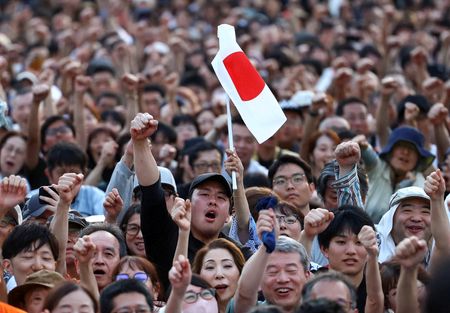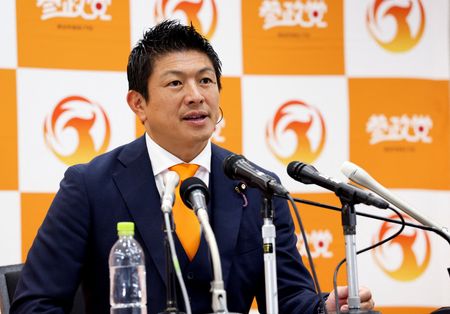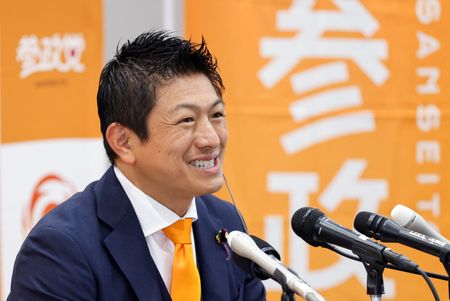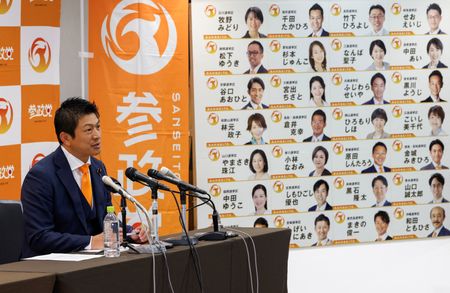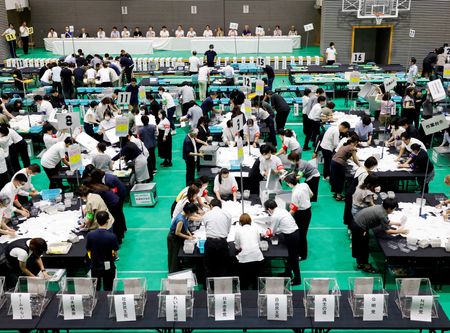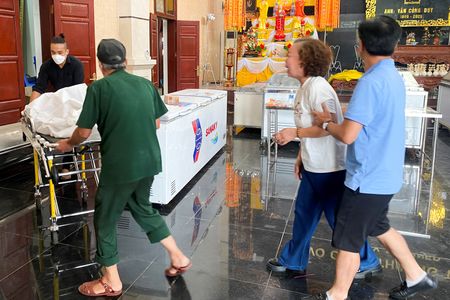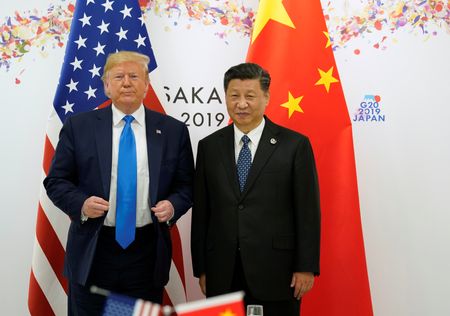By Tim Kelly and John Geddie
TOKYO (Reuters) -The fringe far-right Sanseito party emerged as one of the biggest winners in Japan’s upper house election on Sunday, gaining support with warnings of a “silent invasion” of immigrants, and pledges for tax cuts and welfare spending.
Birthed on YouTube during the COVID-19 pandemic spreading conspiracy theories about vaccinations and a cabal of global elites, the party broke into mainstream politics with its “Japanese First” campaign.
Public broadcaster NHK projected the party to win as many as 22 seats, adding to the single lawmaker it secured in the 248-seat chamber three years ago. It has only three seats in the more powerful lower house.
“The phrase Japanese First was meant to express rebuilding Japanese people’s livelihoods by resisting globalism. I am not saying that we should completely ban foreigners or that every foreigner should get out of Japan,” Sohei Kamiya, the party’s 47-year-old leader, said in an interview with local broadcaster Nippon Television after the election.
Prime Minister Shigeru Ishiba’s Liberal Democratic Party and its coalition partner Komeito will likely lose their majority in the upper house, leaving them further beholden to opposition support following a lower house defeat in October.
“Sanseito has become the talk of the town, and particularly here in America, because of the whole populist and anti-foreign sentiment. It’s more of a weakness of the LDP and Ishiba than anything else,” said Joshua Walker, head of the U.S. non-profit Japan Society.
In polling ahead of Sunday’s election, 29% of voters told NHK that social security and a declining birthrate were their biggest concern. A total of 28% said they worried about rising rice prices, which have doubled in the past year. Immigration was in joint fifth place with 7% of respondents pointing to it.
“We were criticized as being xenophobic and discriminatory. The public came to understand that the media was wrong and Sanseito was right,” Kamiya said.
Kamiya’s message grabbed voters frustrated with a weak economy and currency that has lured tourists in record numbers in recent years, further driving up prices that Japanese can ill afford, political analysts say.
Japan’s fast-ageing society has also seen foreign-born residents hit a record of about 3.8 million last year, though that is just 3% of the total population, a fraction of the corresponding proportion in the United States and Europe.
INSPIRED BY TRUMP
Kamiya, a former supermarket manager and English teacher, told Reuters before the election that he had drawn inspiration from U.S. President Donald Trump’s “bold political style”.
He has also drawn comparisons with Germany’s AfD and Reform UK although right-wing populist policies have yet to take root in Japan as they have in Europe and the United States.
Post-election, Kamiya said he plans to follow the example of Europe’s emerging populist parties by building alliances with other small parties rather than work with an LDP administration, which has ruled for most of Japan’s postwar history.
Sanseito’s focus on immigration has already shifted Japan’s politics to the right. Just days before the vote, Ishiba’s administration announced a new government taskforce to fight “crimes and disorderly conduct” by foreign nationals and his party has promised a target of “zero illegal foreigners”.
Kamiya, who won the party’s first seat in 2022 after gaining notoriety for appearing to call for Japan’s emperor to take concubines, has tried to tone down some controversial ideas formerly embraced by the party.
During the campaign, Kamiya, however, faced a backlash for branding gender equality policies a mistake that encourage women to work and keep them from having children.
To soften what he said was his “hot-blooded” image and to broaden support beyond the men in their twenties and thirties that form the core of Sanseito’s support, Kamiya fielded a raft of female candidates on Sunday.
Those included the single-named singer Saya, who clinched a seat in Tokyo.
Like other opposition parties Sanseito called for tax cuts and an increase in child benefits, policies that led investors to fret about Japan’s fiscal health and massive debt pile, but unlike them it has a far bigger online presence from where it can attack Japan’s political establishment.
Its YouTube channel has 400,000 followers, more than any other party on the platform and three times that of the LDP, according to socialcounts.org.
Sanseito’s upper house breakthrough, Kamiya said, is just the beginning.
“We are gradually increasing our numbers and living up to people’s expectations. By building a solid organization and securing 50 or 60 seats, I believe our policies will finally become reality,” he said.
(Reporting by Tim Kelly and John Geddie and Kantaro Komiya; Editing by Clarence Fernandez and Dale Hudson)

